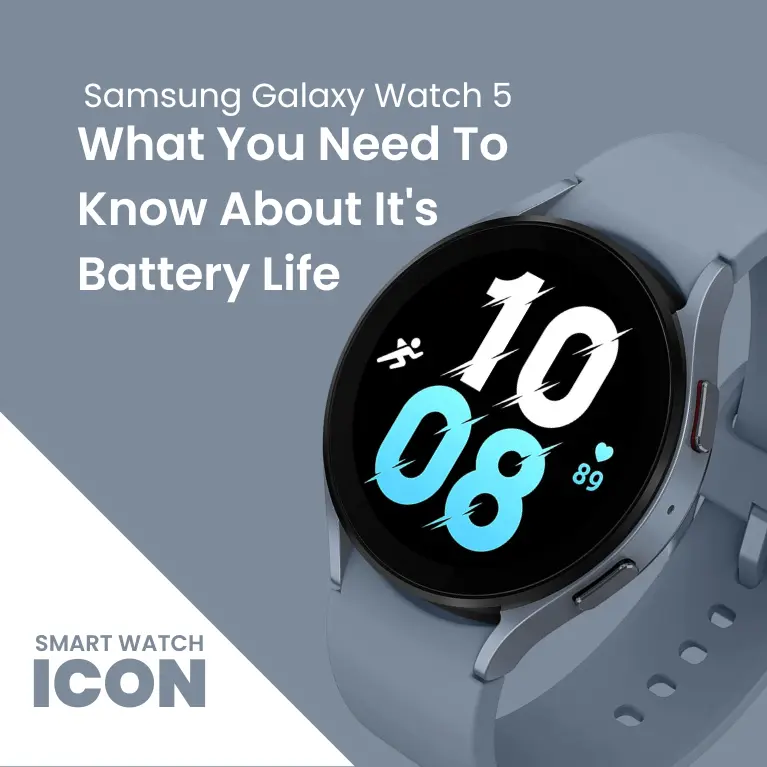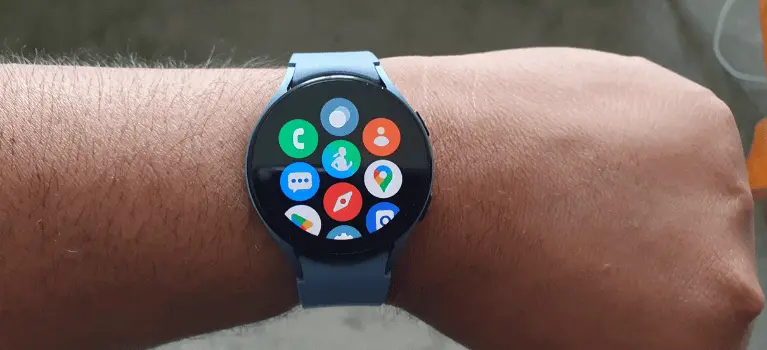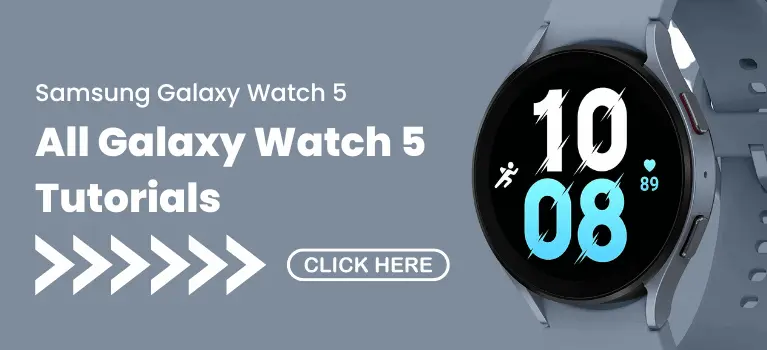Samsung Galaxy Watch 5 : Battery Life Isn’t The Greatest
I was kind of hoping for improved battery life in the new generation Galaxy Watch series and unfortunately, this isn’t the case. Based on my experience with the new Galaxy Watch 5, it’s no better than it’s predecessor the Galaxy Watch 4. In fact it’s the same which is up to 48 hours.
If you had your heart set on buying the new Galaxy Watch 5 and battery life is one of the most important feature you want in a smart watch, then you may want to continue reading this article before you decide to buy. At least that way you can make a conscious decision on whether to buy or not to buy.
I have done some analysis on the Galaxy Watch 5 battery life and in summary this is what I have found.
- Battery consumption rate on non active days is 30%, which is 5% higher than it’s predecessor The Galaxy Watch 4 in power saver mode.
- GPS Battery consumption rate is 12% per hour, which is the same as the Galaxy Watch 4 and the Huawei GT3 which isn’t too bad.
- Based on my personal usage I would get 2 days, if I do long GPS tracking activities I will only get one days worth of battery life
In this article I will explain both bullet points in detail so you can get a better understanding of my analysis.
Updated 09 February 2023
This update is to include the latest update which is the watch only mode. If you are not sure what watch only mode is it’s basically a mode where you turn off your watch.
What do I think of it? it’s pretty good and you definitely gain better battery life but it does come at a cost. If your someone that like to track your stress levels, quick messaging or calling, the watch only mode wont work of you because the Galaxy watch is in sleep mode.
I have written a new article that discuss this new battery saver mode, but to end this quick update I have provided some stats based on my personal experience.
The battery consumption rate without GPS tracking is really based on tracking my strength workout for 60-70 minutes in a day, then I track my sleep at night (bed time mode).
Battery Life Comparison Power Saver Mode vs Watch Only Mode
| Feature | Watch Only | Power Saver |
| No of Days Without GPS Tracking* | 9 | 3 |
| Battery Consumption Rate Without GPS Tracking | 10% Per Day | 30% Per Day |
| No of Days With 1 hour of GPS tracking per day* | 4 | 1.5 days |
| GPS Battery Consumption Rate | 15% per hour | 15% per hour |
| Battery consumption rate with 1 hour GPS tracking | 25% per day | 45% per day |
| Time to recharge battery from 0 to 100% | 150 minutes | 150 minutes |
| Time to recharge 1% of battery | 90 seconds | 90 seconds |
Average Battery Consumption Rate is 30% of Battery Burned Per Day
- AOD (always on display) – 10 screen activations (manually)
- 10 messages viewed
- All day heart rate tracking
- Power saving mode
The above bullet points is the data used which resulted in 30% battery consumption. AOD messages and heart rate and GPS tracking are the biggest battery drainers.
When you come to think of it, 30 percent of battery life consumed is a lot considering it’s a non active day. In fact on other non active days I was consuming 31% and 29%, which is fairly high considering 1/3 of your battery life is gone. Even in power mode the restriction on viewing messages and screen activations (AOD) still does not slow down the battery consumption rate. Which was the same issue I had with the Galaxy Watch 4. If I turned off the power saver mode, I would think that I would lose up to 40% battery life on it’s first day.
In comparison to the Huawei GT3 and the Garmin Forerunner 255 that I tested is at 14-15% battery consumption. Which means the Galaxy Watch 5 battery consumption is 2 times higher.
GPS Battery Consumption Rate 12% Per Hour
Another massive battery drainer is the GPS tracking. Which is why many multi sport specific watch’s like Garmin, Polar and Suunto offer multiple battery saving options on GPS tracking activities. Unfortunately you dont have that luxury with the Galaxy Watch 5, which is a real shame. You only get the generic power saving mode just like the previous model.
As for the 12% GPS consumption rate, this number is pretty good and in comparison to it’s competitors like the Huawei GT3, it’s about the same rate. You could say that the Galaxy Watch 5 does really well in GPS battery consumption, which is a huge plus to many people who do a lot of GPS tracked activities, like running, cycling and swimming.
My Personal Usage
My typical usage is pretty consistent and I tend to do more GPS tracking activities on weekends as I really enjoy the out doors.
Here is a list of my typical activities during the week from Monday to Friday. Based on the list below this will take up 48% of battery life, and therefore need to recharge the next day.
- All day heart rate tracking including sleep tracking
- AOD : 20-25 screen activations
- 50 minutes workout tracking
- 20 messages
- 90 minutes GPS tracking (walking to the gym 15 minutes each way, running at end of day)
Here is a list of activities that I don on the weekend. Based on the list below, this would normally take up at least 66% battery life, and therefore need to charge the watch in the morning.
- All day heart rate tracking including sleep tracking
- AOD : up to 50 screen activations
- 20 messages
- 180 minutes GPS tracking (mountain walks, hiking)
Now that you have an idea of my typical usage and see if it aligns with yours or you can roughly calculate your own typical usage especially anyone who uses GPS tracking during there workouts.
To get a rough estimation of your own battery consumption rate, use 30 percent as your base rate then add roughly the number of hours that you typically do for GPS tracking by 12 (GPS tracking rate per hour). Here is an example calculation based on my typical weekend usage
- base rate is 30%
- number of GPS tracking hours is 3
- Total GPS tracking consumption is 3 X 12 = 36%
- Therefore battery consumption is 30%+36% = 66%
so give it a try and find out what your battery consumption rate would roughly be.
In Conclusion
In the end the battery life of the Galaxy Watch 5 is the same as the Galaxy Watch 4. When it comes to GPS tracking battery consumption, the Galaxy Watch 5 does really well at 12% per hour. Which is the same rate as the Huawei Watch GT3 and Garmin’s Forerunner series.
I would say that the other typical battery drainers such as AOD, messaging and all day heart rate tracking are the major cause for the high battery consumption rate of 30% per day. I personally dont think it’s the heart rate tracker because when I track my battery consumption when sleeping, the battery consumption rate is lower because the watch detects you are sleeping and it shuts off any potential interruptions to your sleep.
If the Samsung Galaxy Watch 5 had the same battery as the Huawei watch’s, the Galaxy Watch 5 would be a fantastic watch. Galaxy watch series has a very nice UI, which is important when seamlessly connecting to so many features built in.
Thank you so much for reading and I hope you found this article useful, if you still find that the battery life of the Galaxy Watch 5 is still good for your needs, then by all means that’s good news.

Updated Test Results : March 2023

Over the last 6 or so months, some really nice updates have been added to the Galaxy watch series and I have to say the user experience is much better than when I first purchased the watch. So if you are thinking of buying the Galaxy Watch 5 where battery life is important to you, then this article will surely be of interest to you
Has Battery Life Improved Since My Last Article
Based on my typical usage, the answer is yes. Was it a big improvement from last time? unfortunately no, however some improvement is better than nothing. Here is a full break down of the before and after results. Please note that this is based on the watch using the power saving mode function.
- All day heart rate tracking including sleep tracking
- AOD : 20-25 screen activations
- 50 minutes workout tracking
- 20 messages
| Feature | Before | After |
| Battery Consumption Rate Without GPS Tracking | 30% Per Day | 25% Per Day |
| No of Days | 3 | 3.5 days |
Based on the results as per the table above, since my last article the Galaxy Watch 5 battery life has improved by 17%. My typical usage has not changed at all, but 17% isn’t a bad number to say the least.
Has the GPS Battery Consumption Improved Since My Last Article?
I would have to say, based on my new test results, the battery consumption rate has definitely improved. Without further a due, let me show you my results of the latest test.
| Feature | Before | After |
| GPS Battery Consumption Rate per Hour | 15% Per hour | 9% Per hour |
Based of my new test results, the Galaxy Watch 5 GPS battery consumption rate has improved by 40%, which is a phenomenal number. It’s also improved it’s ranking as well, going from a 3 star battery consumption rate to a 4 star battery consumption rate. Here is the rating table that I have constructed to rate consistently with all the watches I test.
| No of Stars | GPS Battery Consumption Rate |
| 5 | Up to 7% per hour |
| 4 | 8% to 12% per hour |
| 3 | 13 to 15% per hour |
| 2 | 16 to 19% per hour |
| 1 | 20 % or more |
Even though that the battery consumption rate improved by 40%, How does that number compare to the watches out in the market?, well it’s fair to say it holds very well. This table is based on the watches I have recently tested but as a base point it’s very good.
| No | Brand/Smart Watch | Consumption Rate | Star Rating |
| 1 | Samsung Galaxy Watch 5 Pro | 5% | 5 |
| 2 | Samsung Galaxy Watch 6 Classic | 5% | 5 |
| 3 | Garmin Forerunner 55 | 5% | 5 |
| 4 | Huawei Watch Fit 2 | 5% | 5 |
| 5 | Xiaomi S1 Active | 5% | 5 |
| 6 | Huawei Watch GT3 Pro | 6% | 5 |
| 7 | Huawei Watch GT3 (power saver mode) | 6% | 5 |
| 8 | Polar Ignite 3 | 6% | 5 |
| 9 | Fitbit Versa 4 | 7% | 4 |
| 10 | Samsung Galaxy Watch 5 & 4 | 9% | 4 |
| 11 | Huawei Watch GT3 (performance mode) | 13% | 3 |
| 12 | Fitbit Charge 5 | 20-22% | 1 |
Overall Comparison, How Much Has The Battery Life Improved?
When ever I do a review on the watch’s battery life, I like to separate the GPS battery consumption from your typical usage. GPS tracking is a massive battery drainer, which is the main reason why I review the battery life this way. Below is a overall comparison when you bring the 2 together. Please note that this is based on my typical usage
- Get a extra half day battery life when not using GPS tracking
- Battery life without GPS tracking has improved by 17%
- GPS battery consumption rate has improved by 40%
- Overall battery consumption including 1 hour of GPS tracking per day is 24%, which is a very good number
| Feature | Before | After |
| No of Days Without GPS Tracking* | 3 | 3.5 |
| Battery Consumption Rate Without GPS Tracking | 30% Per Day | 25% Per Day |
| No of Days With 1 hour of GPS tracking per day* | 1.5 | 2.5 days |
| GPS Battery Consumption Rate | 15% per hour | 9% per hour |
| Battery consumption rate with 1 hour GPS tracking | 45% per day | 34% per day |
Final Conclusion With New Test Results
The small improvement in battery life has made my user experience with the Galaxy Watch far better than what it was. I personally dont like to recharge the watch often only because I want to track my sleep.
Since it’s release in September 2022, the Galaxy Watch has really improved over time. I have titled this article that the battery life isn’t the greatest, but over time it’s changed my perspective about the watch’s battery life performance. Back then it earnt that title only because it didn’t quite meet my needs when tracking my GPS tracking workouts, but now that’s all changed.
Also, I dont use the smart features very often. If you are someone that’s very smart feature heavy, then the battery life is going to absolutely burn. In comparison to my typical usage, Im more of a active person.
Thank you so much for reading and I hope these new results will help you gain some confidence before you buy.

